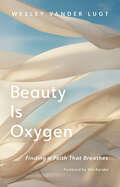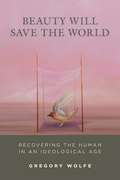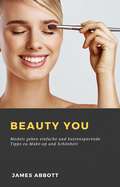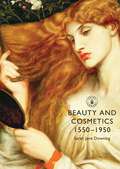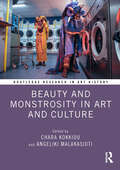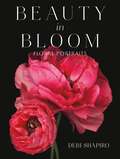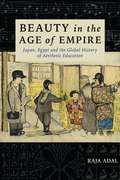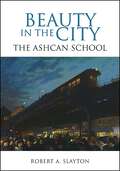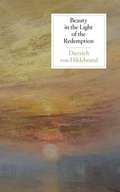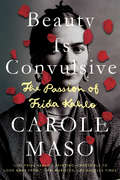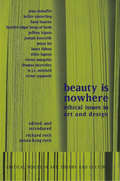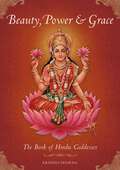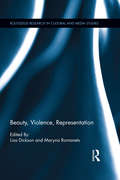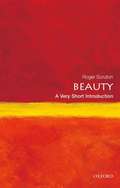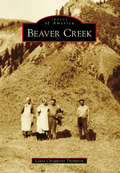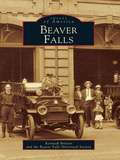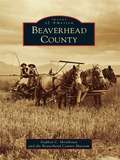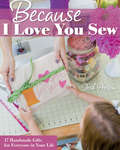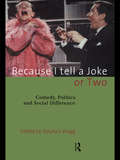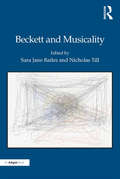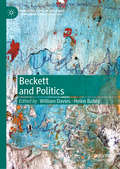- Table View
- List View
Beauty Is Oxygen: Finding a Faith That Breathes
by Wesley Vander LugtBeauty is oxygen because it comes from the lungs of God. Isolating individualism, rank injustice, and everyday monotony threaten to suffocate our souls. But Wesley Vander Lugt shows how beauty can breathe life back into us. Written in a graceful cadence that invites readers to turn these pages slowly, Beauty Is Oxygen weaves together theological reflection, poetry, cultural criticism, and Scripture. Throughout, Vander Lugt shows how beauty can break us out of self-centered malaise, promote healing and hope for our broken world, and reenchant our lives. Beauty is about more than positive feelings or pleasing aesthetics. Beauty is as essential to our souls as oxygen is to our bodies. As readers encounter these traces of divine glory in Vander Lugt&’s finely crafted meditations, they will find how Christ will &“make all things new.&”
Beauty Will Save World: Recovering the Human in an Ideological Age
by Gregory WolfeA writer in residence at Seattle Pacific University, Wolfe founded and edits the literature and arts journal Image. Here he shares his thoughts about how Christian humanism can improve the world. His sections cover from ideology to humanism; Christianity, literature, and modernity; six writers; three artists; and four men of letters. Among his topics are a portrait of the editor as a young man, the writer of faith in a fractured culture, Evelyn Waugh, Wendell Barry, Mary McCleary, and Malcolm Muggeridge. Annotation ©2011 Book News, Inc. , Portland, OR (booknews. com)
Beauty You Consejos De Belleza y Maquillaje Simples y De Bajo Costo Que Usan Las Modelos
by James Abbott Andrea M. Aedo¡No pierdas tiempo con transformaciones caras y largas! En esta guía aprenderás los consejos más efectivos y de bajo costo ¡para transformarte en una modelo! Las supermodelos internacionales normalmente utilizan estos métodos y hasta un principiante los puede aplicar en unos minutos. Esto es lo que incluye: -Consejos simples -Métodos de bajo costo -Cómo aplicar maquillaje en solo unos minutos -Cómo parecer una modelo -El mejor maquillaje para cualquier aplicación Aviso Legal: El autor o dueño(s) de los derechos de autor no promete ni garantiza la precisión, integridad o adecuación de los contenidos de este libro y expresamente renuncia a la responsabilidad por errores y omisiones dentro de su contenido. Este producto solo está destinado a ser usado como referencia.
Beauty You: Models geben einfache und kostensparende Tipps zu Make-up und Schönheit
by James AbbottKümmere dich nicht um teure, zeitaufwändige Umgestaltungen! In diesem Handbuch erfahren Sie die effektivsten und kostengünstigsten Tipps, um Sie in ein Modell zu verwandeln! Diese Methoden werden häufig von den Topmodels der Welt verwendet und können sogar von Anfängern innerhalb weniger Minuten angewendet werden. Folgendes ist enthalten: - Einfache Tipps - Kostengünstige Methoden - Tragen Sie das Make-up schnell in nur wenigen Minuten auf - Sieh aus wie ein Model - Das beste Make-up für jede Anwendung -> Scrollen Sie zum Anfang der Seite und klicken Sie auf In den Warenkorb, um sofort zu kaufen. Haftungsausschluss: Dieser Autor und / oder Rechteinhaber machen keine Ansprüche, Zusagen oder Garantien hinsichtlich der Richtigkeit, Vollständigkeit oder Angemessenheit des Inhalts dieses Buches und lehnen ausdrücklich die Haftung für Fehler und Auslassungen im Inhalt ab. Dieses Produkt dient nur als Referenz.
Beauty and Cosmetics 1550-1950
by Sarah DowningExhibiting enormous power or inspiring incredible devotion, throughout history beauty has been women's chief asset. Each age has required its own standard - a gleaming white brow during the Renaissance, the black eyebrows considered charming in the early 18th century, or the thin lips thought desirable to the Victorians. For those naturally blessed, their beauty could ensure a good marriage, offer social mobility, fame or notoriety whereas those without such obvious gifts would resort to any ends to achieve an illusion of beauty. Ours is not the only age when beauty is celebrated but also judged and quantified. From the color of the ear to the transparency of the teeth the benchmark for every aspect of beauty has been set and women - and some men - have applied themselves wholeheartedly risking their lives using poisonous chemicals, their fortunes at the risk of blackmail, or the wrath of God, to reach the desired targets.From Queen Elizabeth I who used dangerous quantities of white lead to give her complexion the illusion of a youthful lustre, to Marilyn Monroe who blended 4 shades of lipstick to emphasise her perfect pout this book will examine some of the more unusual cosmetic practices contemplated in beauty's name.
Beauty and Human Existence in Chinese Philosophy
by Keping WangThis book considers the Chinese conception of beauty from a historical perspective with regard to its significant relation to human personality and human existence. It examines the etymological implications of the pictographic character mei, the totemic symbolism of beauty, the ferocious beauty of the bronzeware. Further on, it proceeds to look into the conceptual progression of beauty in such main schools of thought as Confucianism, Daoism and Chan Buddhism. Then, it goes on to illustrate through art and literature the leading principles of equilibriumharmony, spontaneous naturalness, subtle void and synthetic possibilities. It also offers a discussion of modern change and transcultural creation conducted with particular reference to the theory of the poetic state par excellence (yi jing shuo) and that of art as sedimentation (ji dian shuo).
Beauty and Monstrosity in Art and Culture (Routledge Research in Art History)
by Chara Kokkiou Angeliki MalakasiotiThis edited volume takes a new look at an old question: what is the relationship between beauty and monstrosity? How has the notion of beauty transformed through the years and how does it coincide with monstrous ontologies? Contributors offer an interdisciplinary approach to how these two concepts are interlinked and emphasize the ways the beautiful and the monstrous pervade human experience.The two notions are explored through the axis of human transformation, focusing on body, identity, and gender, while questioning both how humans transform their body and space as well as how humans themselves are gradually transformed in different contexts. The pandemic, gender crisis, moral crisis, sociocultural instability, and environmental issues have redefined beauty and the relationship we have with it. Exploring these concepts through the lens of human transformation can yield valuable insights into what it means to be human in a world of constant change.The book will be of interest to scholars working in art history, archaeology, philosophy, architecture, and cultural studies.
Beauty in Bloom: Floral Portraits
by Debi ShapiroA poppy bud captured moments before blossoming. A statuesque tuberose as if carved out of alabaster. A pair of delicate pink dahlias joined like two starfish floating in the sea.Beauty in Bloom is the debut collection of work by Debi Shapiro, a visual artist who creates beautiful imagery inspired by her two passions—flowers and photography. More than 200 floral portraits in this exquisite book capture the depth and luminosity of a single bloom to lush bouquets with breathtaking intimacy and vibrant energy. Every translucent petal, tender green stem, and grain of pollen shimmers with painterly detail reminiscent of the works of the great botanical artists and engravers of the eighteenth century. From the bold crimson beauty of an Oriental poppy to the seductive lure of a pink Protea peeking out from behind its thick foliage to the timeless classic beauty of a garden rose, it&’s a flower lover&’s dream. Debi&’s work truly makes every bloom a leading lady.
Beauty in the Age of Empire: Japan, Egypt, and the Global History of Aesthetic Education (Columbia Studies in International and Global History)
by Raja AdalWhen modern primary schools were first founded in Japan and Egypt in the 1870s, they did not teach art. Yet by the middle of the twentieth century, art education was a permanent part of Japanese and Egyptian primary schooling. Both countries taught music and drawing, and wartime Japan also taught calligraphy. Why did art education become a core feature of schooling in societies as distant as Japan and Egypt, and how is aesthetics entangled with nationalism, colonialism, and empire?Beauty in the Age of Empire is a global history of aesthetic education focused on how Western practices were adopted, transformed, and repurposed in Egypt and Japan. Raja Adal uncovers the emergence of aesthetic education in modern schools and its role in making a broad spectrum of ideologies from fascism to humanism attractive. With aesthetics, educators sought to enchant children with sounds and sights, using their ears and eyes to make ideologies into objects of desire. Spanning multiple languages and continents, and engaging with the histories of nationalism, art, education, and transnational exchanges, Beauty in the Age of Empire offers a strikingly original account of the rise of aesthetics in modern schools and the modern world. It shows that, while aesthetics is important to all societies, it was all the more important for those countries on the receiving end of Western expansion, which could not claim to be wealthier or more powerful than Western empires, only more beautiful.
Beauty in the City: The Ashcan School (Excelsior Editions)
by Robert A. SlaytonGold Medalist, 2018 Independent Publisher Book Awards in the US Northeast -Best Regional Non-Fiction CategoryFinalist for the 2017 Foreword INDIES Book of the Year Award in the Regional categorySilver Winner, 2017 Foreword INDIES Book of the Year Awards in the History categoryAt the beginning of the twentieth century the Ashcan School of Art blazed onto the art scene, introducing a revolutionary vision of New York City. In contrast to the elite artists who painted the upper class bedecked in finery, in front of magnificent structures, or the progressive reformers who photographed the city as a slum, hopeless and full of despair, the Ashcan School held the unique belief that the industrial working-class city was a fit subject for great art. In Beauty in the City, Robert A. Slayton illustrates how these artists portrayed the working classes with respect and gloried in the drama of the subways and excavation sites, the office towers, and immigrant housing. Their art captured the emerging metropolis in all its facets, with its potent machinery and its class, ethnic, and gender issues. By exposing the realities of this new, modern America through their art—expressed in what they chose to draw, not in how they drew it—they created one of the great American art forms.
Beauty in the Light of the Redemption
by Dietrich Von Hildebrand"What importance is to be attributed to beauty in the life of a Christian? What role should it play in the life of those who have been redeemed? What is the relationship between redemption and beauty? Did beauty lose its significance after the redemption?" These are some of the questions the author answers in this collection of essays, which introduces his philosophy of art, truth, and beauty.
Beauty is Convulsive: The Passion of Frida Kahlo
by Carole Maso"Maso's incantatory description of her conjured–up subject's embrace takes on extraordinary power . . . Like Frida Kahlo's painting—impossible to look away from." —Kai Maristed, Los Angeles TimesAt the age of eighteen, Frida Kahlo’s life was transformed when the bus in which she was riding was hit by a trolley car. Pierced through by a steel handrail and broken in many places, she entered a long period of convalescence during which she began to paint self–portraits.A vibrant series of prose poems, Beauty Is Convulsive is a passionate meditation on Frida Kahlo, one of the twentieth century’s most compelling artists. Carole Maso brings together pieces from Kahlo’s biography, her letters, medical documents, and her diaries to assemble a text that is as erotic, mysterious, and colorful as one of Kahlo’s paintings.
Beauty is Nowhere: Ethical Issues in Art and Design (Critical Voices in Art, Theory and Culture)
by Saul OstrowThis book is an important addition to the discourse on contemporary ethical issues in art and design. Beauty is Nowhere makes a timely contribution to the necessary explanation of the relationship of ethics to art and design practice, and the ability of the arts to matter as we approach the next millennium. From informal discussion to formal essay, distinguished theoreticians and practitioners of art explore issues of political space, user- centred design, the social responsibility of the artist, design legislation, cultural hierarchy, modernism as colonialism, and the ethical opportunities and minefields of postmodernism. This volume grew out of a thematic lecture series: Ethical Issues in Art and Design sponsored by the Centre for Interdisciplinary Studies in Art and Design, College of the Arts, The Ohio State University.
Beauty's Rigor: Patterns of Production in the Work of Pier Luigi Nervi
by Thomas LeslieBorn in Sondrio, Italy, in 1891, Per Luigi Nervi was a pioneer in the engineering and architecture of reinforced concrete. His buildings showed how the use of reinforced concrete expanded the possibilities of form and structure. His methods, meanwhile, ingrained his structures with patterns that came directly out of his economical, manual construction processes. The results were buildings that matched awe-inspiring spans with surprisingly human scale. Beauty's Rigor offers a comprehensive overview of Nervi's long career. Drawing on the Nervi archives and a wealth of photographs and architectural drawings, Thomas Leslie explores celebrated buildings like Palazetto dello Sport built for the 1960 Rome Olympics, St. Mary's Cathedral in San Francisco, and the UNESCO headquarters in Paris. He also sheds new light on unbuilt projects such as the Pavilion of Italian Civilization for the Universal Exposition of Rome E42. What emerges is the first complete account of Nervi's contributions to modern architecture and his essential role in a revolution that realized concrete's potential to match grace with strength.
Beauty, Power and Grace: The Book of Hindu Goddesses
by Krishna DharmaReplete with inspired illustrations by award-winning artists B.G. Sharma and Mahaveer Swami, Beauty, Power & Grace features Krishna Dharma&’s dramatic retellings of pivotal ancient Indian stories of the many Hindu Goddesses.Adapted from ancient Sanskrit texts, the stories in Beauty, Power & Grace represent one of the most fundamental aspects of Hinduism—the innumerable manifestations of divinity. Among these, the portrayal of the Goddess is perhaps the most alluring. She appears as a devoted wife, a master of the arts, a terrifying demon slayer, a scornful critic, and a doting mother, to name just a few of her forms. In Vedic tradition, these depictions of the Goddess reflect the belief that male and female are simply different expressions of one supreme, absolute truth. These profound stories are brought together here in an exquisitely illustrated collection that reveals the various manifestations of the Goddess, ranging from the iconic to the obscure: Mother Yashoda peers into her infant&’s mouth and is astonished to catch a glimpse of the entire universe; Ganga Devi, now synonymous with the sacred river, rides upon a great crocodile and purifies those whom she encounters; and Kali, adorned with a garland of skulls, drinks the blood of her victims on the battlefield. A definitive and timeless celebration of Goddess imagery, symbolism, and lore, Beauty, Power & Grace stunningly displays the fascinating intersection between color, form, and meaning at the heart of Hindu tradition.
Beauty, Violence, Representation (Routledge Research in Cultural and Media Studies)
by Lisa Dickson Maryna RomanetsThis volume explores the relationship among beauty, violence, and representation in a broad range of artistic and cultural texts, including literature, visual art, theatre, film, and music. Charting diversifying interests in the subject of violence and beauty, dealing with the multiple inflections of these questions and representing a spectrum of voices, the volume takes its place in a growing body of recent critical work that takes violence and representation as its object. This collection offers a unique opportunity, however, to address a significant gap in the critical field, for it seeks to interrogate specifically the nexus or interface between beauty and violence. While other texts on violence make use of regimes of representation as their subject matter and consider the effects of aestheticization, beauty as a critical category is conspicuously absent. Furthermore, the book aims to "rehabilitate" beauty, implicitly conceptualized as politically or ethically regressive by postmodern anti-aesthetics cultural positions, and further facilitate its come-back into critical discourse.
Beauty: A Very Short Introduction
by Roger ScrutonBeauty can be consoling, disturbing, sacred, profane; it can be exhilarating, appealing, inspiring, chilling. It can affect us in an unlimited variety of ways. Yet it is never viewed with indifference. In this Very Short Introduction, the renowned philosopher Roger Scruton explores the concept of beauty, asking what makes an object--either in art, in nature, or the human form--beautiful, and examining how we can compare differing judgments of beauty when it is evident all around us that our tastes vary so widely. Is there a right judgment to be made about beauty? Is it right to say there is more beauty in a classical temple than a concrete office block, more in a Rembrandt than in an Andy Warhol Campbell Soup Can? Forthright and thought-provoking, and as accessible as it is intellectually rigorous, this introduction to the philosophy of beauty draws conclusions that some may find controversial, but, as Scruton shows, help us to find greater sense of meaning in the beautiful objects that fill our lives.
Beaver Creek
by Laura Chiappetta ThompsonSince 1883, Beaver Creek has attracted adventurous individuals. The allure of precious minerals brought miners to the valley, and many stayed after the illusion of striking it rich began to fade. Those folks homesteaded and farmed or ranched. Ranching flourished for a few families until the early 1970s. Two men credited with developing the Vail ski area set their sights on the Beaver Creek drainage for a new ski resort. Political battles over permits stretched from Denver to Washington, DC. In addition, environmental issues burgeoning in the early 1970s added another layer of complexity to the proposed ski area. Dark days were looming as interest rates hit 18 percent and a recession hit the national economy. A silver lining in all the turmoil at the fledgling resort occurred when former president Gerald R. Ford bought one of the first residential lots, making Beaver Creek his address. The original visionaries' goal to build a world-class resort was on its way to completion after years of challenges.
Beaver Falls: Gem Of Beaver County (Images of America)
by Kenneth Britten Beaver Falls Historical SocietyBeaver Falls, known as Brighton before itsincorporation, is located in the western corner ofPennsylvania. During its first one hundred fifty years, residents of the town built it into a self-supporting community committed to family values. Extensive industrial development occurred during this period, and the city was described as "one of the most well-established manufacturing towns in western Pennsylvania." Carefully preserved images from the Beaver Falls Historical Society are combined with revealing and informative text in Beaver Falls. This fascinating new history includes some of the homes and businesses of early Beaver Falls families, and the railroad, canal, and river that connected Beaver Falls to the rest of the state. Newly discovered images and sources of the community's history make this exciting new book a rare and timeless keepsake.
Beaverhead County (Images of America)
by Stephen C. Morehouse Beaverhead County MuseumBeaverhead County, located in southwest Montana, sits at the top of the Missouri River drainage. In 1805, Lewis and Clark navigated the river 20 miles south of Dillon and met peacefully with the Shoshone tribe. Settlement was sparse until the discovery of gold in 1862, when the town of Bannack sprang up overnight to become the first territorial capital. The number of towns in the county grew quickly with new discoveries of gold, silver, lead, and copper. Other settlers came to raise cattle and sheep and to cultivate hay and grain. As these new arrivals flooded the area, the resident Shoshone and Bannock tribes were displaced from their land and banished to a reservation in Idaho. The first railroad came up from Corinne, Utah, in 1880, and new communities were established along the tracks. While the mining settlements eventually declined, the rail towns survived, and today many ghost towns remain in Beaverhead County as a reminder of the not-so-distant past.
Beazley's Design and Detail of the Space between Buildings
by A. PinderA new edition of a book widely regarded as a classic of landscape architecture, it deals with the 'bits' that go in between the different parts of the urban landscape. A completely updated text makes it suitable for both the professional and student.
Because I Love You Sew: 17 Handmade Gifts for Everyone in Your Life
by Trish PrestonUse your sewing superpower to create holiday, special occasion, and just because presents for moms, dads, kids, friends, and others! Don&’t just say it . . . sew it! Show everyone in your life how much you love them with this gift-making book, Because I Love You Sew, by Trish Preston. Its charming collection of 17 projects features quilts, stylish totes, pretty holiday decor, and more! Includes patterns for all skill levels, step-by-step directions, and plenty of inspiring ideas for making each gift even more personal. &“Inspires us anew to appreciate the &‘why&’ of these creations formed with our hands and hearts. We enjoyed the insight into Trish&’s family, her thoughts on gift giving and her lovely projects.&”—Generation Q Magazine &“Give the gift of handmade this holiday. Pick from vintage ice skate Christmas stockings and small projects, such as a fabric bicycle basket or a recipe binder cover. Or commemorate a special occasion with a wedding memories collage, birthday celebration shirt, and family tree crazy quilt.&”—Quilts & More
Because I Tell a Joke or Two: Comedy, Politics and Social Difference
by Stephen WaggBecause I Tell a Joke or Two explores the complex relationship between comedy and the social differences of class, region, age, gender, sexuality, ethnicity and nationhood. It shows how comedy has been used to sustain, challenge and to change power relationships in society. The contributors, who include Stephen Wagg, Mark Simpson, Stephen Small, Paul Wells and Frances Williams, offer readings of comedy genres, texts and performers in Britain, the United States and Australia. The collection also includes an interview with the comedian Jo Brand. Topics addressed include: * women in British comedies such as Butterflies and Fawlty Towers * the life and times of Viz, from Billy the Fish to the Fat Slags * queer readings of Morecambe and Wise, the male double act * the Marx brothers and Jewish comedy in the United States * black radical comedy in Britain * The Golden Girls, Cheers, Friends and American society.
Beckett and Musicality
by Nicholas Till Sara Jane BailesDiscussion concerning the ’musicality’ of Samuel Beckett’s writing now constitutes a familiar critical trope in Beckett Studies, one that continues to be informed by the still-emerging evidence of Beckett’s engagement with music throughout his personal and literary life, and by the ongoing interest of musicians in Beckett’s work. In Beckett’s drama and prose writings, the relationship with music plays out in implicit and explicit ways. Several of his works incorporate canonical music by composers such as Schubert and Beethoven. Other works integrate music as a compositional element, in dialogue or tension with text and image, while others adopt rhythm, repetition and pause to the extent that the texts themselves appear to be ’scored’. But what, precisely, does it mean to say that a piece of prose or writing for theatre, radio or screen, is ’musical’? The essays included in this book explore a number of ways in which Beckett’s writings engage with and are engaged by musicality, discussing familiar and less familiar works by Beckett in detail. Ranging from the scholarly to the personal in their respective modes of response, and informed by approaches from performance and musicology, literary studies, philosophy, musical composition and creative practice, these essays provide a critical examination of the ways we might comprehend musicality as a definitive and often overlooked attribute throughout Beckett’s work.
Beckett and Politics: Politics, Propaganda And A 'universe Become Provisional' (New Directions in Irish and Irish American Literature)
by William Davies Helen BaileyThis collection of essays reveals the extent to which politics is fundamental to our understanding of Samuel Beckett’s life and writing. Bringing together internationally established and emerging scholars, Beckett and Politics considers Beckett’s work as it relates to three broad areas of political discourse: language politics, biopolitics and geopolitics. Through a range of critical approaches, including performance studies, political theory, gender theory, historicizing approaches and language theory, the book demonstrates how politics is more than just another thematic lens: it is fundamentally and structurally intrinsic to Beckett’s life, his texts and subsequent interpretations of them. This important collection of essays demonstrates that Beckett’s work is not only ripe for political engagement, but also contains significant opportunities for understanding and illuminating the broader relationships between literature, culture and politics.
